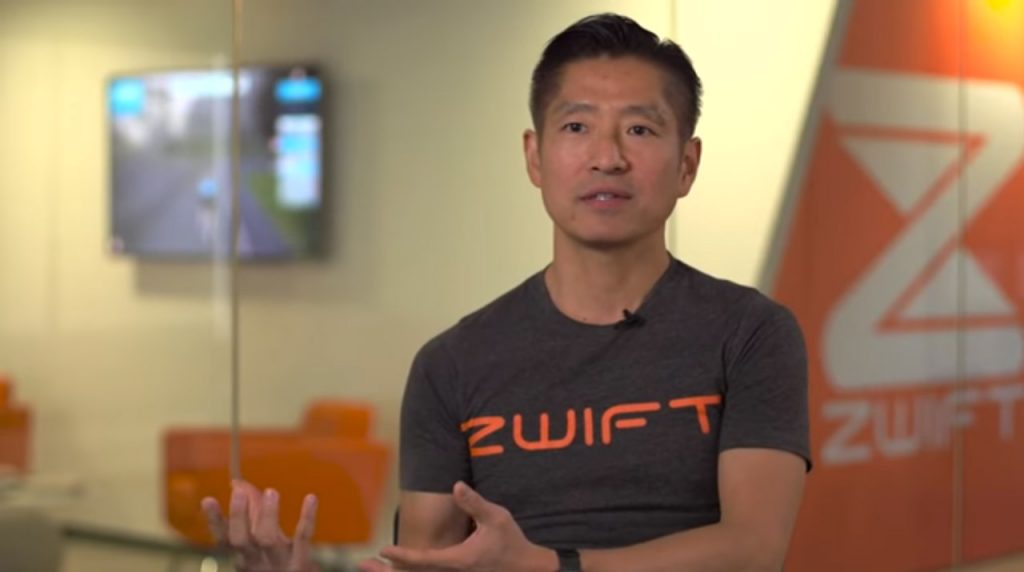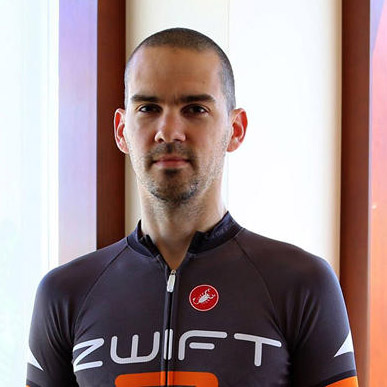Zwift – an archetype for a new age

Zwift is an archetypal new generation brand.
It was founded by a serial entrepreneur, someone who had previously set up other technology-based brands, in this case Sakonnet Technology. There are parallels here with Uber, Chewy and GoPro, to mention just three others founded by serial entrepreneurs.
It’s a brand that has allowed Eric Min and his co-founders to turn their passion into profits. Chewy set up by its dog-loving founders is another classic example.
It solved a problem the founder had personally, in this case the monotony of indoor cycling. For the founders of Warby Parker it was the high price of new glasses.
It’s a technology-based brand rather than a brand that sees itself in a market to disrupt. Uber sees itself as a technology platform brand, as does AirBnB. Zwift too sees itself as a platform, though sometimes it describes itself as an entertainment company.
It has cleverly combined different elements and made 1+1=3.
It has an aspirational vision “to create the most engaged and socially active fitness platform.” Maybe not as worthy as some, like Google, but clear and directional, allowing scope for expansion.
It has and tells its own story…and this is my take on that story based mainly on interviews Eric Min and Jon Mayfield have given and shared on the Zwift website.
It begins with a seven-year-old Eric learning to cycle, a good start but as in many stories then came a setback. Just as he was getting proficient his family relocated to NYC, not somewhere conducive to young children cycling. It would be another seven years before Eric was able to rediscover cycling. One of his friends, Travis Millman, introduced him to what he now calls “proper cycling” showing off his Kotobuki touring bike, Bell helmet, and leather gloves. Eric remembers being hooked instantly and he joined a local racing club. While still enamoured with riding and the gear that went with it, he remembers that “it was the sense of community, camaraderie and competitiveness that led me to fall in love with cycling.” He found he loved the friendly competition during training or social rides even more than racing.

Despite it being “a mind-numbing experience” he started riding indoors when he was 15 years old, as it allowed him to maintain his fitness over the cold, wet and snowy winters or leading up to an important event. However, h really missed the social aspect of training.
He continued to cycle over the years while he was working at JP Morgan and then in 1998 he set up Sakonnet Technology with Alarik Myrin. They sold it in 2012/3 and decided to look for the next venture. Eric’s older brother Ji told him to stick to what he knew best which fitted with Alarik’s suggestion that he should take a look at cycling.
So reflecting on his current cycling routine, he realised that because of work and family commitments he rarely got outside on his bike and he was doing most of his riding indoors, which just wasn’t as enjoyable.
This led to what Eric calls his “moment of eureka”. He thought “What if we could take something that was historically mind numbing and turn it into entertainment? What if we could take advantage of video game technology, social networks, and friendly competition, and package that experience for the indoor cyclist?”
He started to sound other cycling friends out about the idea and they were all encouraging. He decided to explore the possibility more thoroughly and convinced an old friend and fellow cyclist to join him. They travelled across the US and Europe speaking to enthusiasts and industry professionals seeing if they were interested and also checking no-one else was working on something similar already. Getting a positive response and hearing no-one else had the same vision they decided to ramp up the project.
It was about this time that Min saw an online post by a programmer called Jon Mayfield in which he described a “3D trainer program” he was developing as a hobby project. Min promptly contacted Jon and arranged to meet.

Jon was a cycling ‘addict’ too and rather like Eric the realities of being a responsible adult and father got in the way of his riding. So, he too had taken up riding indoors and like others found it “awfully boring”. With few other options and having made video games for a dozen years he decided to see if he could do something for himself. Starting in the Christmas vacation in 2010 he began writing the first lines of code in his spare bedroom. Over the next 2-3 years he would do another couple of hours here and there when he could, creating both the code and art.

Occasionally, he’d post about his software on various Internet forums and it was one of these that Eric saw. Jon too remembers the first meeting. “Hands were shook, partnerships formed, and at the end of January 2014, I quit my job. The future of indoor cycling was underway.”
Looking back on that first meeting Eric recalls how impressed he was with what Mayfield had already done: “It helped us to visualize the experience we wanted to create. It didn’t take long to convince Jon to join us as a founding member of Zwift. The rest is history.”
So early in 2014, Jon Mayfield, Eric Min, Scott Barger and Alarik Myrin co-founded Zwift Inc. Zwift was chosen as the name as the team felt it combined motion and fun, two of the key elements of the brand.

The first ‘world’ the team created was “Jarvis Island” and it was released as an invite-only beta product on September 30, 2014. They had 1,000 places to fill but were surprised and delighted when they got 13,000 applications.
The launch reflected the global ambitions of the brand and its ability to link people across continents, it took place simultaneously in Rapha Clubhouses in London, New York City and San Francisco.
By May 2015 Zwift had moved into open beta and a virtual version of the Richmond (Virginia) 2015 UCI Road World Championships Course was introduced on September 3, 2015.
On October 30, 2015, Zwift launched as a fully-fledged product with a $10 monthly subscription fee. Since then it has accelerated away and today sees itself as an entertainment company catering to the cyclist and the runner but looking for further future potential.
And the moral is … some stories have lots of morals, lots of lessons